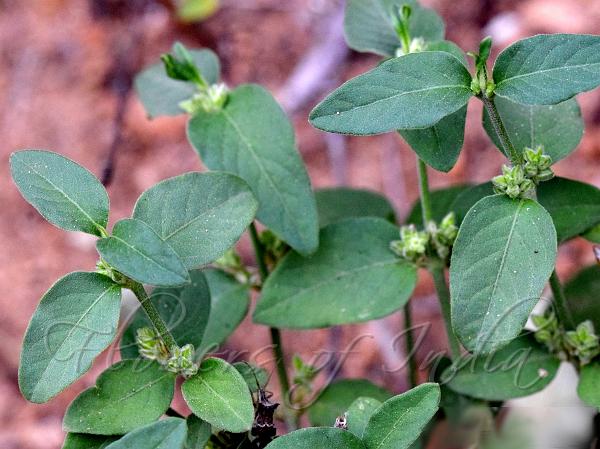|
| Spreading Psilotrichum |
|

|

| File size | 935354 |
| Original date | 8/22/16 10:30 AM |
| Resolution | 2048 x 1536 |
| Flash | Flash did not fire |
| Focal length | 90.0mm |
| Exposure time | 1/800s |
| Aperture | 10.0 |
| Focus Distance | |
| Metering Mode | Multi-segment |
| Camera make | NIKON CORPORATION |
| Camera model | NIKON D3300 |
| Sensor type | OneChipColorArea |
|
|
|
|
Photo: |
Botanical name: Psilotrichum patulum Family: Amaranthaceae (Amaranth family)
Synonyms: Celosia patula, Psilotrichum elliotii, Psilotrichum ovatum
Synonyms: Celosia patula, Psilotrichum elliotii, Psilotrichum ovatum
Spreading Psilotrichum is a perennial herb,
somewhat woody at the base, creeping and forming mats up to 1.2 m
across or scrambling among low vegetation, considerably branched from
the base and often also above. It is named for Stephen Elliott, 19th
century South Carolina (American) botanist. Stem and branches in the
older parts round, striped, finally becoming hairless at the base,
quadrangular and grooved when young, densely furnished with long white
hairs, not swollen at the nodes. Leaves are ovate to broadly oblong,
1-5 x 0.8-2.75 cm, rounded to shortly tapering at the mucronate tip,
rounded, nearly flat to shortly wedge-shaped at the base, nearly
stalkless and semi-stem-clasping or with a leaf-stalk up to 5 mm. long,
moderately or rarely densely furnished on both surfaces with rather
long subappressed white hairs, sometimes becoming hairless above with
age. Inflorescences are rather short spikes 6-8 mm. wide and finally
elongating to 1.5-3 cm., at branch-ends and generally 2 at each node in
the leaf-axils, stalkless or on very slender flower-cluster-stalks up
to 3 cm. long; bracts deltoid-ovate, 2-2.5 mm., densely white hairy;
bracteoles are broadly heart-shaped-ovate, 1 mm. Flowers are stalkless.
Tepals membranous, strongly 3-ribbed and greenish centrally with broad
pale margins; the 2 outer lanceshaped to oblong-lanceshaped, 3-4 mm.
The intermediate tepal long-hairy along one margin. Stamens are 1.75
mm., very delicate. Capsule is oblong-ovoid, 1.5 mm. Seed are ovoid, 1
mm., compressed, brown, shining, faintly netveined. Spreading
Psilotrichum is native to Asia-Tropical and Africa.
Medicinal uses: Leaf paste is given to improve
eyesight.
Leaf paste is given to improve
eyesight.
Medicinal uses:
 Leaf paste is given to improve
eyesight.
Leaf paste is given to improve
eyesight. | Identification credit: S. Kasim | Photographed in Udumalpet, Tamil Nadu. |
• Is this flower misidentified? If yes,